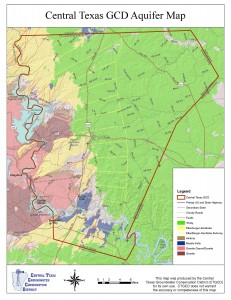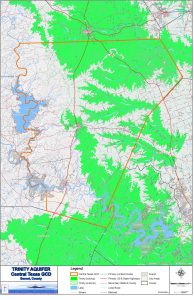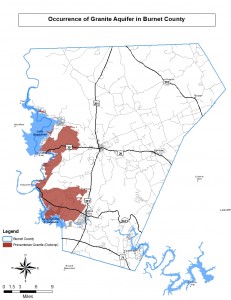Groundwater Resources of Burnet County
Burnet County enjoys a variety of groundwater resources. TWDB recognizes one major and three minor aquifers in the County. In addition to the aquifers defined by TWDB, there also exist two local water bearing formations that are important sources of water in Burnet County.
Trinity
The Trinity aquifer is composed of three subdivisions; the Upper Trinity, Middle Trinity, and the Lower Trinity aquifers. The Upper Trinity aquifer is composed of the Paluxy Sand and Glen Rose Formation; the Middle Trinity aquifer is composed of the Hensell Sand and Cow Creek Limestone; and the Lower Trinity aquifer is composed of the Sligo Limestone and Hosston Sand. The Upper Trinity aquifer crops out in the majority of eastern and central Burnet County. The Middle Trinity has a limited outcrop in Burnet County, which occurs at or near the western most extent of the Trinity aquifer.
Upper Trinity
• The Paluxy overlies the Glen Rose and is present in the upland inter-stream areas. The formation is thin and unrecognizable during drilling. The Paluxy is not a source of
groundwater in the District.
• The Glen Rose overlies the Hensell Sand and is a limited source of groundwater in the District. The primary limitation is saturated thickness. The Glen Rose Limestone is considered a source of groundwater. Well yields are sufficient for domestic and livestock use, but the formation is geographically limited due to being un-saturated or having a low saturated thickness. The Glen Rose generally yields 10-15 gpm wells.
Middle Trinity
• The Hensell Sand is the primary source of groundwater in the Trinity aquifer of the District. Except for wells completed in the Ellenburger below the Trinity in the western part of the Trinity area, the vast majority of wells are completed in the Hensell. Well yields in the Hensell are generally in the range of 10-40 gpm. However, along the Hwy. SH-29, well yields are frequently estimated to be greater than 50 gpm, and even up to 100+ gpm.
• The Cow Creek, being below the Hensell sand is saturated, but yields very little significant groundwater. The Cow Creek is not considered a significant source of groundwater in the District.
Lower Trinity
• The Hosston is present in the extreme eastern and southeastern part of the District. It is generally thin and not a significant source of groundwater in the District.
Ellenburger-San Saba Aquifer
- The Ellenburger-San Saba aquifer occurs along the margin of the Llano Uplift in Central Texas. Discontinuous outcrops of the aquifer surround older rocks of the uplift, and the remaining downdip portion may extend to depths of up to 3,000 feet below land surface. It is unknown if the aquifer reaches this depth in Burnet County.
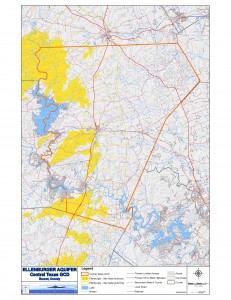
- The aquifer is compartmentalized by block faulting. The aquifer is composed of the limestone and dolomite of the San Saba Member of the Wilberns Formation of late Cambrian age, and the Honeycut, Gorman, and Tanyard formations of the Ellenburger Group of early Ordovician age. Water occurs in solution cavities formed along faults and related fractures.
- Water produced from the aquifer may be hard but have less than 1,000 mg/l dissolved solids. (Ashworth and Hopkins, 1995) The recharge zone for the aquifer in Burnet County is approximately 110,413 acres.
- Three-fourths of the water pumped from the aquifer is used for municipal water supplies at Fredericksburg, Johnson City, Bertram, and Richland Springs. Also, a large portion of water flowing from San Saba Springs, which is the water supply for the city of San Saba, is believed to be from the Ellenburger-San Saba and Marble Falls aquifers.
Hickory Aquifer
- The Hickory aquifer occurs in the Llano Uplift region of Central Texas. Non-continuous Hickory Sandstone outcrops may overlie or flank exposed Precambrian rocks forming the central uplift core. The downdip (artesian) portion of the aquifer surrounds the uplift and may extend to depths approaching 4,500 feet. It is unknown if the aquifer occurs at this depth in Burnet County. The Hickory Sandstone Member of the Cambrian Riley Formation is one of the oldest sedimentary rock formations in Texas. In the southern and eastern extents of the aquifer, the Hickory consists of two units. The flow of the Hickory aquifer is restricted due to block faulting.
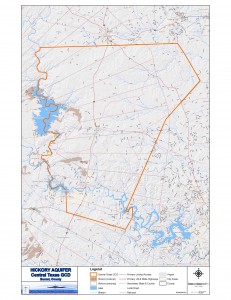
- Water from the aquifer is generally fresh, but locally may have alpha particle and radium concentrations in excess of drinking water standards. The water may contain radon gas. The Hickory may produce water with iron concentrations exceeding drinking water standards. (Ashworth and Hopkins, 1995) Water which exceeds a drinking water standard must be treated to meet or exceed the drinking water standard established by the United States Environmental Protection Agency before it may be distributed by a public water supply system.
- The Hickory aquifer occurs in parts of 19 counties in the Llano Uplift region of Central Texas.
- The recharge zone of the aquifer in Burnet County is approximately 18,011 acres.
- Most of the water pumped from the aquifer is used for irrigation. The largest capacity wells, however, have been completed for municipal water-supply purposes at Brady, Mason, and Fredericksburg.
Marble Falls Aqufier
- The Marble Falls aquifer occurs in several separated outcrops along the northern and eastern flanks of the Llano Uplift. Water occurs in fractures and solution cavities in the limestone of the Marble Falls Formation of the Pennsylvanian Bend Group. Maximum thickness of the formation is 600 feet, but the thickness in Burnet County is unclear. The quality of water produced from the aquifer is suitable for most purposes.
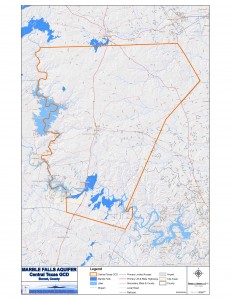
- The Marble Falls Aquifer provides water to parts of Blanco, Burnet, Lampasas, McCulloch, and San Saba counties, and to even smaller parts of Kimble, Llano, and Mason counties in Central Texas. San Saba and Rochelle are the two largest communities that withdraw water from the aquifer for public supply use. Wells have been reported to yield as much as 2,000 gal/min; however, most wells produce substantially less.
- Where underlying beds are thin or absent, the Marble Falls and Ellenburger-San Saba aquifers may be hydrologically connected. Numerous large springs issue from the aquifer and provide a significant part of the baseflow to the San Saba River in McCulloch and San Saba counties, and to the Colorado River in San Saba and Lampasas counties.
- The recharge zone of the aquifer in Burnet County is approximately 15,790 acres.
Granite Gravel Aquifer
- The Granite Gravel Aquifer is a local water bearing formation located in the southwest portion of Burnet County. It is located in what is known as the Llano Uplift area of Central Texas. The Precambrian Town Mountain Granite is part of the core of the Llano uplift and is the formation that forms the Granite Gravel Aquifer. The Town Mountain Granite is described as being coarse-grained, pink, quartz-plagioclase-microcline rock. In Burnet County much of the formation is decomposed and weathered on the surface and down to the bedrock.
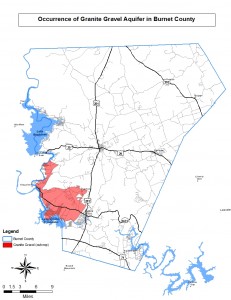 The Granite Gravel Aquifer is composed of weathered or decomposed Town Mountain Granite. A solid bedrock of granite forms the base of the aquifer and its depth below surface can vary greatly. The saturated thickness of the aquifer is dependent on the depth to the bedrock which can range from a few feet in some locations, and up toward 100 ft in others. There exist locations in which the granite bedrock is exposed to the surface or just beneath it, therefore these areas contain little to no granite gravel.
The Granite Gravel Aquifer is composed of weathered or decomposed Town Mountain Granite. A solid bedrock of granite forms the base of the aquifer and its depth below surface can vary greatly. The saturated thickness of the aquifer is dependent on the depth to the bedrock which can range from a few feet in some locations, and up toward 100 ft in others. There exist locations in which the granite bedrock is exposed to the surface or just beneath it, therefore these areas contain little to no granite gravel.
- Flow in the Granite Gravel Aquifer is controlled by the depth to the top of the granite bedrock and presence of adjacent geologic formations that have been juxtaposed to the granite in some instances. The variations in the depth to the granite bedrock cause well yields to vary widely throughout the aquifer. Estimated well yields for the aquifer can range from as little as 5 gpm up to 100+ gpm.
Granite Aquifer
- The Granite Aquifer is a general name for the water bearing formation that is composed of various Precambrian formations, which consist mostly of Town Mountain Granite and Valley Spring Gneiss among others. In Burnet County the Granite Aquifer outcrops in the western part of the county mainly along the highland lakes west of HWY 281. The downdip portion surrounds the Llano Uplift and generally dips to the east.
